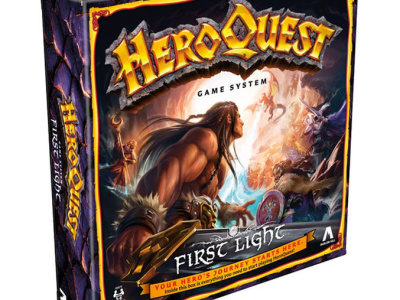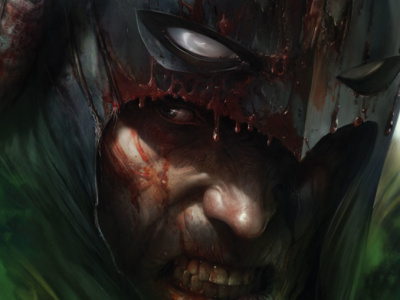
ICv2 talked recently with IDW Publishing CEO and President Ted Adams. In Part 1 of the interview he talks about the state of the market, the fact that digital has become a significant part of the publisher’s business, the effect of increasing digital sales on print sales, and digital pricing. In Part 2 Adams talks about his new position at the company, IDW’s varied product mix and some of the publisher’s major initiatives for 2012. In Part 3 Adams comments on IDW’s approach to Judge Dredd, other key licensed titles like Star Trek and the Teenage Mutant Ninja Turtles, as well as the fate of the Locke & Key TV series.
Can you give us an overview of the comics and graphic novel market over the past year from your perspective?
From IDW’s perspective the business is frankly, kind of booming. Our direct market revenue is up in a way that I haven’t seen in a really long time. It certainly seems like comic book stores are seeing a lot of new customers come in, and we’re seeing not only our preorders up, but our FOC numbers are almost always up, and reorder activity is at an all-time high both for the comic book versions and for the graphic novels. We’re finding ourselves constantly being surprised by the demand and going back to press on both the comic book versions and the trade paperbacks.
What do you attribute that to?
There’s no way to know for certain, but I think the DC re-launch really brought in a lot of new or maybe lapsed readers, and those folks were looking to read things beyond what DC was doing. It’s the one thing that I can identify of the magnitude that it would bring in the level of readers that it did.
What are you seeing on the bookstore side after the loss of Borders?
The Borders revenue you can’t replace so there’s a hit there no question. I do think that from our perspective it’s a better bottom line business for us with Borders gone, but certainly that top line number has gone down.
Do you feel like the other channels and retailers have picked up what they lost, or is some of that sales revenue just gone forever?
Certainly we’ve seen increases with Barnes and Noble and Amazon both, so some of those Borders customers have migrated to other places, but yeah, I think the reality is that some of that revenue is probably just gone.
Last year you said the digital share of your revenues were insignificant. Is that still the case?
No, it is not the case anymore. Oddly enough, digital for us is almost exactly 10% of our direct market revenue, and I don’t know why that is. It’s like dollar to dollar, from a percentage standpoint, which is just a weird coincidence but it’s been holding true, and digital revenue continues to increase at an unbelievable rate for us.
I suspect that while it’s 10% right now when we’re talking again next year it wouldn’t surprise me if it’s 15% or maybe 20% of our direct market revenue. Keep in mind that’s with an increase in direct market revenue. I was just looking at our numbers and we’re year to year at a 25% increase in direct market revenue, and we’ve had a 150% digital publishing revenue increase year to year. So both markets are doing unbelievably well for us.
There’s just no question at this point that selling comics digitally is definitively not impacting [print] comic book sales. If anything you could make the argument that the success of digital is driving more print comic book sales. The correlation at this point is that increased digital has resulted in increased print. Whether or not that is a direct correlation, I don’t know how you would figure that out. I can say with no uncertainty that our increased digital revenue has come at a time when we’ve had increased comic book sales.
What’s the key thing driving the increase in digital right now?
That’s a good question. It’s got to be the number of people walking around with the devices. You see everybody with an iPad now. It’s a ubiquitous device and people are discovering comic books on the iPad in a way that they probably haven’t before. Maybe we’re talking about lapsed readers, people who fell out of the habit of going to comic book stores for whatever reason, and they’ve stumbled upon the comiXology app and got back into the habit of reading comics. And some of those people who were lapsed readers have migrated back to the print versions as well.
Comic books are a unique print medium from the standpoint that people want to own the print version of comic books so if you’re a lapsed comic book reader and you get back into the hobby through the iPad, I don’t think it’s a stretch to say that that makes you want to go back to your comic book store and start picking up physical books again. There’s just something about owning your comic book that’s not the same as owning a daily newspaper or Time Magazine.
The Transformers: Autocracy project was interwoven with the print books with digital first. How did that work as a product and as a tie-in to the print?
Our idea was to do something that was a digital release first, with the idea that we could potentially build some excitement around that. Autocracy which is the digital first release, ties so closely into our core Transformer comic books and the re-launch of the Transformer comic books that we did this year, we really felt like we could play those markets and rise all boats by having some continuity and some content available digitally in the print and regular comics. There’s some evidence that that worked. Autocracy significantly outperformed our expectations. We set our projections fairly low because we had no idea what a digital first comic book release would look like. It’s 10 times what we thought it would sell, and our Transformers comics, both digital and print versions, have sales up significantly over the last 12 months.
Will you collect the Autocracy story-line sometime?
We are. The plan is that we’re going to do a collection that comes out around the same time as the last episode appears digitally. It’ll end up from the print standpoint as a sort of original graphic novel since it didn’t appear in physical comic books before. It’s a test for us. It’s hard for us to project what it’s going to sell because we’ve never done something like this before.
You said the digital results were ten times what you expected. Does that mean you’re going to do more of this kind of thing?
It does. Absolutely.
IDW has been fairly aggressive with its approach to digital in terms of platforms and getting content out there. Are there things you won’t do digitally due to concerns about impact on the print market?
We’ve gone day and date like most of our competitors, and we’re making sure the price remains the same [for digital and print]. Nothing is off the table. Some books are more difficult to format for digital, and we’re trying to figure out how those books will work digitally, like with Library of American Comics. We came out with a beautiful Flash Gordon book and the whole point of that book is that it’s oversized; it’s the strips at the actual size for the first time. It’s a beautiful book, and I’m not convinced that book really works for the iPad. There are some limitations with digital.
We’ve always tried to have our books--from a print production standpoint--be as good as they can possibly be, and I think if you look at our Eisner Award nominations, we’re starting to get some recognition for our print design and graphic design and the way we present our physical books. A lot of those things just can’t be done with an iPad, so again, if you’re looking at something like Flash Gordon or the Artist Editions we’ve been coming out with, they can’t exist in a digital format.
Have you done any pricing experiments?
We’ve done some 99 cent sales digitally and we’ve been figuring out what works from a 99 cent standpoint--same kind of thing that most publishers are dealing with comiXology. You’re not going to ever see us doing a day and date where we decrease the price for digital on the same day that we’re asking a higher price for the physical book. That’s not going to happen.
Click here for Part 2.







